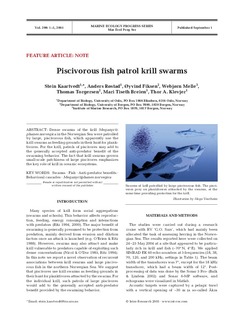| dc.contributor.author | Kaartvedt, Stein | |
| dc.contributor.author | Røstad, Anders | |
| dc.contributor.author | Fiksen, Øyvind | |
| dc.contributor.author | Melle, Webjørn | |
| dc.contributor.author | Torgersen, Thomas | |
| dc.contributor.author | Breien, M. T. | |
| dc.contributor.author | Klevjer, Thor A. | |
| dc.date.accessioned | 2010-11-30T10:05:10Z | |
| dc.date.available | 2010-11-30T10:05:10Z | |
| dc.date.issued | 2005-09-01 | |
| dc.identifier.issn | 0171-8630 | |
| dc.identifier.issn | 1616-1599 | |
| dc.identifier.uri | http://hdl.handle.net/11250/108434 | |
| dc.description | Journal homepage: http://www.int-res.com/journals/meps/ | en_US |
| dc.description.abstract | Dense swarms of the krill Meganyctiphanes norvegica in the Norwegian Sea were patrolled by large, piscivorous fish, which apparently use the krill swarms as feeding grounds in their hunt for planktivores. For the krill, patrols of piscivores may add to the generally accepted anti-predator benefit of the swarming behavior. The fact that krill swarms govern small-scale patchiness of large piscivores emphasizes the key role of krill in oceanic ecosystems. | en_US |
| dc.language.iso | eng | en_US |
| dc.publisher | Inter Research | en_US |
| dc.subject | behavioral studies | en_US |
| dc.subject | atferdsstudier | en_US |
| dc.subject | schooling fish | en_US |
| dc.subject | stimfisk | en_US |
| dc.title | Piscivorous fish patrol krill swarms | en_US |
| dc.type | Journal article | en_US |
| dc.type | Peer reviewed | en_US |
| dc.subject.nsi | VDP::Agriculture and fishery disciplines: 900::Fisheries science: 920::Resource biology: 921 | en_US |
| dc.subject.nsi | VDP::Mathematics and natural science: 400::Zoology and botany: 480::Marine biology: 497 | en_US |
| dc.subject.nsi | VDP::Mathematics and natural science: 400::Zoology and botany: 480::Ecology: 488 | en_US |
| dc.source.pagenumber | 1-5 | en_US |
| dc.source.volume | 299 | |
| dc.source.journal | Marine Ecology Progress Series | |
| dc.identifier.doi | http://dx.doi.org/10.3354/meps299001 | |
